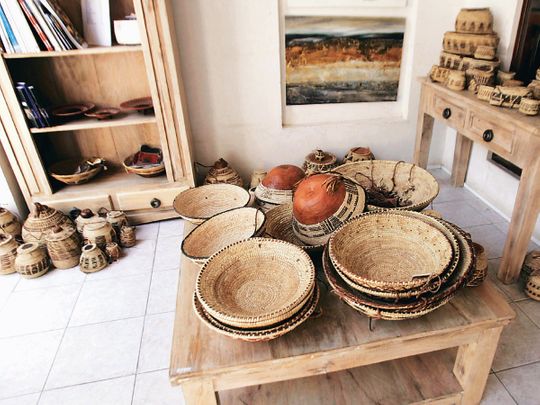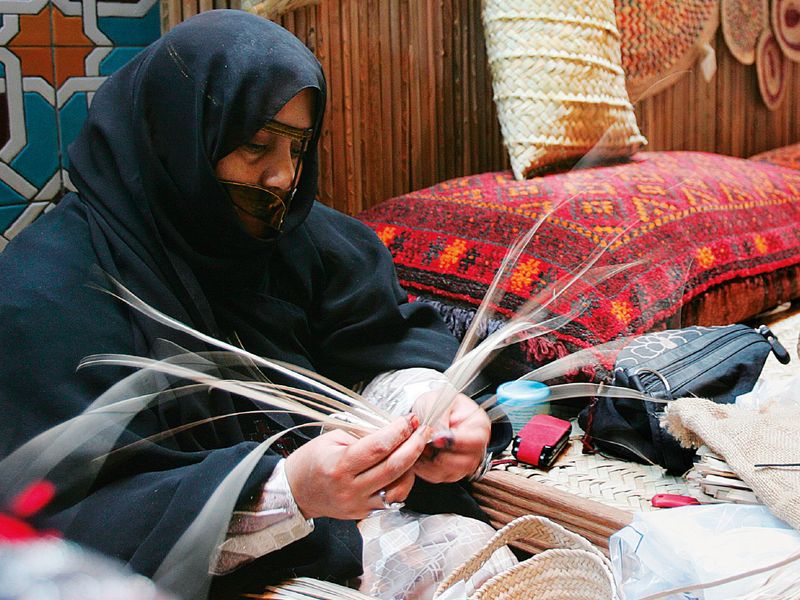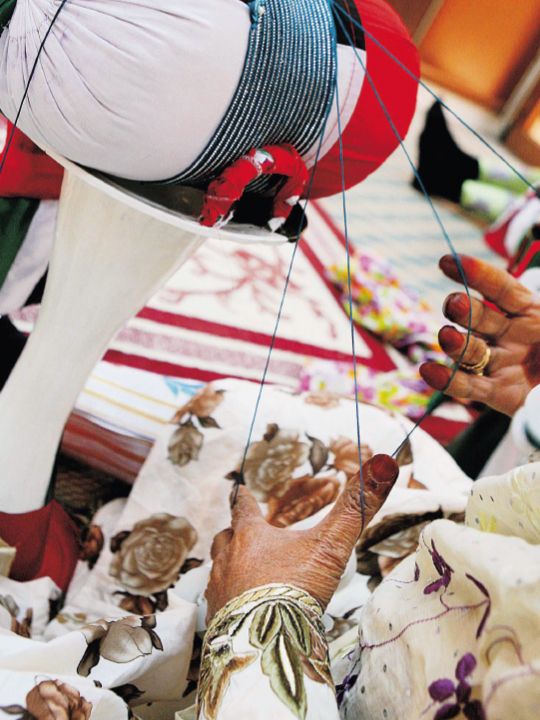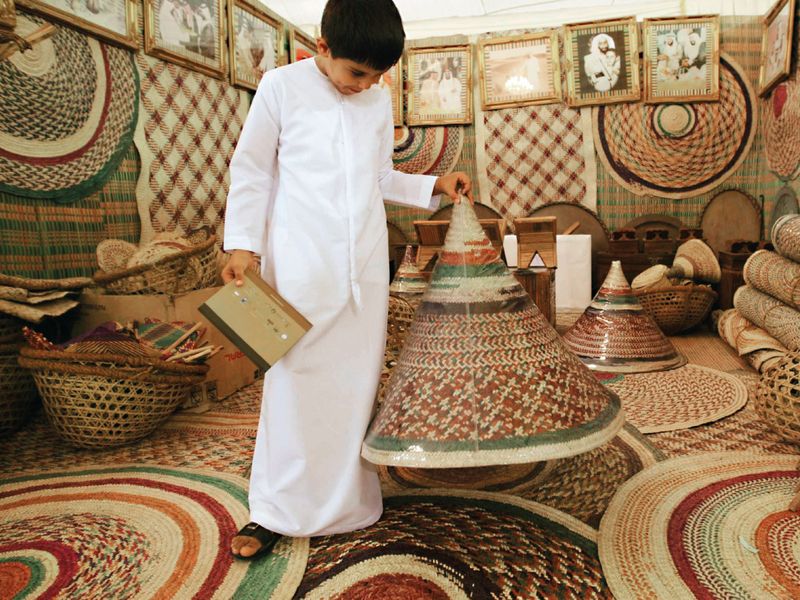
Dubai’s fashion industry may be in the midst of a boom, but locally designed items are nothing new in the UAE. For many years, local women have been creating arts and crafts items for themselves and their friends and families, through traditional Emirati handicraft and weaving techniques. Sadly however, the ladies who can create these crafts are a dying breed, with many of them being from the older generations. But all is not lost – locally based groups and government agencies are working hard to revive and preserve the ancient techniques that are part of Emirati culture. They are striving to promote them to the younger generation and much more diverse audience of tourists and expats to ensure this ancient culture does not die out.
For decades, Emirati women have been practicing a number of types of handicrafts to produce items for clothing, the home and as gifts. The art of each of these crafts is usually passed down from generation to generation by women from Emirati families. Many of these families are originally from small towns and villages and could not afford, or did not have access to, the luxurious items owned by the rich. So, many years ago they decided to create handmade crafts with materials found in the home or garden to replicate items and decorations that were commonly only worn or owned by rich, or royal families. There is even today, a real sense of community between these women who love to pass on their techniques to friends and family members, selling and sharing the crafts that they make in their homes. While the UAE cities are all about big designer brands and shopping malls, if you travel to the smaller communities it is clear that these traditional creations very much live on in the small communities that these ladies live in.

However, there is a problem. With the influx of tourists to the UAE over the last few decades, as well as the increasing number of Emirati’s leaving their homes to study abroad or travel, these crafts are much less common than they were some decades ago. While older women are still continuing to create handmade items, they will soon rely on the younger generations to keep the techniques alive. “The ladies who are making these crafts are generally retired and in many cases grandmothers. They have been creating crafts for many generations,” says Shareefa Hasan Al Dhuhoori, manager of the The Bidwa Social Development Programme Centre in Dibba, which is working to keep the art of ‘Talli’ (a form of hand-woven braid that is added to clothing), alive. The centre, which falls under the Irthi Contemporary Crafts Council works to preserve crafts such as the ‘Talli’ and make them relevant in today’s world. Irthi Contemporary Crafts was developed under the NAMA Women Advancement Establishment, a Sharjah-based organisation that aims to empower and support women in the region.
While we believe everyone can learn to make Emirati handicrafts, patience is key to mastering the skills.
The centre has already been a great success since its opening in 2016, with over 30 retired ladies now coming to work and to create these crafts. Last year, the centre was lucky enough to be chosen to partner with international luxury accessories brand, Asprey to create a limited edition range of bags. The collection was quite suitably named ‘One Stitch at a Time’. The centre has also created ‘Talli’ designs for Emirati-Inspired catwalk looks for The Accademia Italiana, during the prestigious Alta Roma fashion week in Rome. As the centre continues to grow, there are big plans for these ladies with future collaborations already in the works. The ‘Tallis’ these ladies are making are quite remarkable. The technique looks very complicated, yet they finish with flawless designs so it’s no wonder they have already been picked up internationally.

Shareefa Hasan Al Dhuhoori says, “Many modern people in the UAE do not care for these kinds of crafts. They want to go to the mall and get the latest handbag or designer item. For this reason, we are targeting the European market. To them this is something different and exotic. We would however love to sell ‘Tallis’ to brands in the UAE, we just need to find the right partnership.” While you cannot buy the ‘Tallis’ themselves directly from the centre, the ladies are selling their crafts at markets throughout the year, Shelifa explains: “We have the ladies at events showing what they are doing. We regularly go to markets and events in Sharjah to showcase the ‘Tallis’. The feedback is amazing. Everyone is asking about them, what they are and how the ladies are doing it.”
The centre isn’t the only place in the UAE working to keep traditions alive. Al Ain Palace Museum is offering free weekly interactive workshops that explore the heritage of a number of crafts and teach visitors how to create them. Local women are teaching crafts including ‘Talli’, ‘Sadu’ (an ancient tribal weaving craft made with wool and cotton yarn) and ‘Khoos’ (another type of palm leaf weaving). “Al Ain Palace Museum’s mandate is to preserve and revive the heritage and traditions that were integral to Al Ain and early Emirati life. We believe in safeguarding our tradition and celebrating our culture as a lifestyle and allowing everyone access to learn from it,” explains Sumaya Khalfan Al Mehrezi, Marketing and Communications Officer at Al Ain Palace Museum. The classes, which are taught by elderly Emirati women, have had a particular interest from tourists, expats and also school children who are curious in learning about the history of the place they are growing up in. “We want to celebrate and spread awareness of our national identity, while teaching the young Emirati generation crafts their ancestors used to make and trade with.” Says Sumaya. “While we believe everyone can learn to make Emirati handicrafts, patience is key to mastering the skills,” She continues.

Aside from the classes it’s now possible to find Emirati handicrafts at events and shows across the country, helping to raise awareness and grab the attention of a new audience. The Liwa Dates Festival takes place annually and celebrates the palm tree and all its uses. The event includes a traditional Emirati market where you can find local women making crafts from palm leaves. A group of women will sit and weave together throughout the week, selling some of their creations to visitors and giving tourists a glimpse of what desert life was like for them while growing up. Similarly, the Al Dhafra Camel Festival in Abu Dhabi exhibits colourful traditional handicrafts used as bridles for camels. Visitors to the event can buy these. Sharjah Heritage week, that takes place every year in April, has a host of events throughout the week, which celebrate locally made crafts. You will find everything from hand-woven Emirati flags to stylish ‘Tallis’ that can be purchased and applied to clothing. The events tend to attract visitors from all over the UAE.
When you look around today, there is no denying the UAE is now a very modern country, with the tallest, shiniest buildings, state-of-the-art technology and, of course, the stunning five star hotels, which are constantly popping up. However, it is quite reassuring to know that the country continues to keep these fascinating crafts alive. Thanks to organisations such as the Irthi Contemporary Crafts council, locally made crafts are beginning to get international recognition and be noticed by those outside of the small Emirati community. The history is still very much alive.


